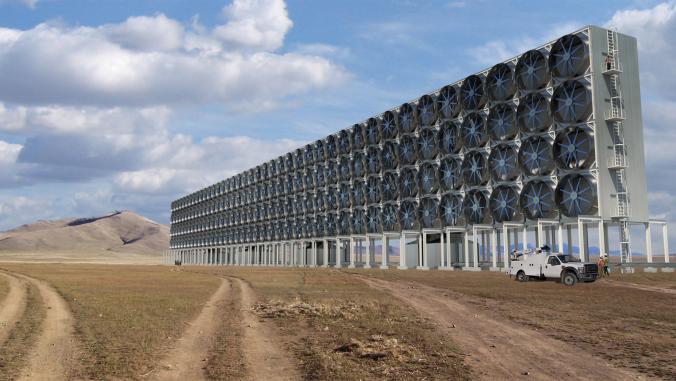What does climate change mean to China's security?
Although China has taken action on climate change, its military and security agencies haven't formally acknowledged the threats.

A recent report by Zheng Haibin, a professor at Peking University, highlights the potential impact of climate change on China’s national security. Haibin claims that climate change will endanger China’s defense and damage critical strategic infrastructure. Specifically, he called out several vulnerabilities:
- Reduced rainfall and increased temperatures will lead to desertification in the dry north and west, stretching already thin water supplies, threatening the decades-old Green Great Wall. Increasing temperatures in the west could cause thawing permafrost to buckle hundreds of miles of the newly constructed, multi-billion-dollar Qinghai-Tibet Railway, jeopardizing this strategic link to Tibet.
- Extreme weather events, such as flooding, drought and cyclones, will degrade or compromise a variety of critical and security-related infrastructure across China. Heavy mountain rainfall could trigger mudslides and landslides that would render useless numerous fixed missile launch sites used by the Second Artillery Corps, China’s strategic missile force. Fluctuating water levels and river runoff substantially could affect the output of the Three Gorges Dam. Farming capacity could fall 5 to 10 percent by 2030. Increased cyclone activity over the last decade along the Chinese coastline has caused extensive damage, restricted army training and degraded combat effectiveness. Even the new Chinese-Russian oil pipelines across China’s vast interior could be vulnerable to extreme weather events.
- Coastal exposure in China is enormous, with over 11,000 miles of coastline, 6,700 islands and enormous ocean-side cities. Climate change-induced sea-level rise may be China’s principal threat. Threats include retreating coastlines, ecosystem damage and salt-contamination of water supplies, not to mention ocean inundation and shifting geopolitical boundaries. Strategic energy corridors, maritime rights and fisheries are also at substantially increased risk.
Zheng’s proposed approach for what he calls “climate change securitization” has included forming a national group to address climate change and strengthening coordination between the army, national security agencies and local decision-making bodies.
Unlike in the United States, the Chinese security establishment has yet to issue any formal acknowledgement of these threats.
Officially, according to a white paper describing China’s military strategy, climate change is considered a “non-traditional” security threat.
However, Wilson VornDick, a U.S. Navy Commander at the Pentagon, previously assigned to the Chinese Maritime Studies Institute at the U.S. Naval War College, suggests in the Diplomat that some Chinese military analysts share Zheng’s concerns.
His own assessment is:
Chinese authorities either do not see or fail to acknowledge the threat from climate change. But China should begin the process of intertwining climate change preparation and response into its broader national security framework now. If China does not act, it will not be able to prepare, respond, or adapt to the impacts from climate change as effectively as it could. This would be a disastrous choice for the CCP and the Chinese people.
Of course, China has taken significant action on climate change, ranging from Beijing banning coal burning in the city to new commitments reached jointly with the United States.
Given the fact the China’s carbon emissions growth rate has been averaging 7 percent annually, while the world average is 2.8 percent, it’s a good thing that action is being taken. The joint U.S. agreement commits China to stop growing emissions, and to begin declining by 2030. But the issues of security and climate are not being uttered in the same sentence — not in Chinese, not very often, yet.
British Foreign Secretary Phillip Hammond was in China this month for high-level security talks that are supposed to touch on climate change, among other topics.
Other efforts in place include the China Climate Security Initiative, a joint effort between the Stockholm Environment Institute, Stockholm International Peace Research Institute, Third Generation Environmentalism, Beijing University and a U.S. partner to be named in the future. The group has “a clear imperative from a security, foreign policy and climate perspective to better understand China’s climate security challenges, response drivers, and their potential impact on regional security.”
Finally, a major report issued last year by the Center for American Progress, “Climate Change, Migration, and Nontraditional Security Threats in China” (PDF), states:
Climate change and social stability present enormous hurdles for China at its current stage of economic development as it emerges as a global leader. Without addressing the climate security risks posed by greenhouse gas emissions, migration hotspots, and social stability, China’s emergence as a stable world partner and the legitimacy of the Chinese Community Party will be challenged. China’s leadership has made some headway in the disparate policy realms of climate change, rural-to-urban migration, urbanization, human security, and resource scarcity, but no overarching policy exists to link them together to mitigate complex crisis scenarios.
The report goes on to suggest, “While China has shown its capacity to make progress on certain resource, environmental, and security issues, much more interagency coordination, targeted resources, and mechanisms for policy implementation must be in place.” The analysis appears to materially agree with Zheng.
This story first appeared on:





